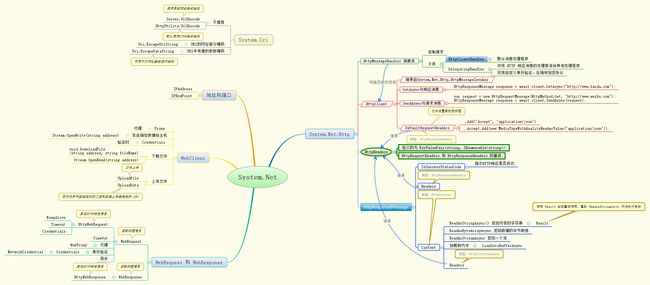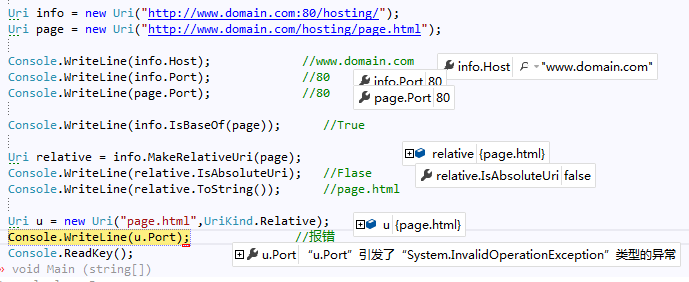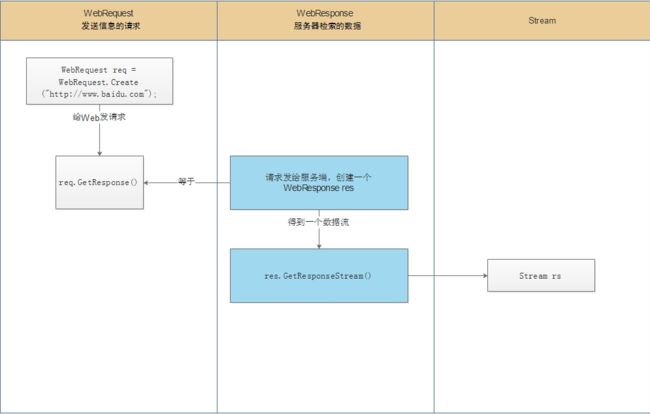16.1 网络体系结构
System.Net.* 命名空间包含各种支持标准网络协议的通信。
WebClient外观类:支持通信HTTP或FTP执行简单的下载/上传操作。WebRequest和WebResponse类:支持更多的客户端HTTP或FTP操作。HttpListener类:可用来编写HTTP服务器。SmtpClient类:支持通过 SMTP 创建和发送电子邮件。DNS类:支持域名和地址之间的转换。TcpClient、UdpClient、TcpListener和Socket类:支持传输层和网络层的直接访问。
16.2 地址与端口
IPv4
- 目前主流,32位。用点号分隔的4个十进制数(101.102.103.104)。地址可能是唯一,也可能是一个特定子网中的唯一(例如,企业网络)。
IPv6
- 128位地址。这些地址用冒号分隔的十六进制数(例如,
[3EA0:FFFF:198A:E4A3:4FF2:54fA:41BC:8D31])。.NET FrameWork要求加方括号。
System.Net 命名空间的 IPAddress 类是采用其中一种协议地址。它有一个构造函数可以接收字节数组,以及一个静态的 Parse 方法接收正确字符串:
IPAddress a1 = new IPAddress(new byte[] { 101, 102, 103, 104 });
IPAddress a2 = IPAddress.Parse("101.102.103.104");
Console.WriteLine(a1.Equals(a2)); //true
Console.WriteLine(a1.AddressFamily); //InterNetwork
IPAddress a3 = IPAddress.Parse("[3EA0:FFFF:198A:E4A3:4FF2:54fA:41BC:8D31]");
Console.WriteLine(a3.AddressFamily); //InterNetworkV6TCP和UDP协议将每一个IP地址划分为65535个端口,从而允许一台计算机在一个地址上运行多个应用程序,每一个应用程序使用一个端口。许多应用程序都分配有标准端口,例如,HTTP使用端口80,SMTP使用端口25。
49152到65535的TCP和UDP端口官方保留,它们只用于测试和小规模部署。
IP地址和端口组合在.NETFramwork 使用 IPEndPoint 类表示:
IPAddress a = new IPAddress(new byte[] { 101, 102, 103, 104 });
IPEndPoint ep = new IPEndPoint(a, 222); //端口:222
Console.WriteLine(ep.ToString()); //101.102.103.104:22216.3 URI
URI描述了一个 Internet 或 LAN 的资源,例如网页。文件或电子邮件地址。
URI一般氛围三个元素:协议(scheme)、权限(authority)和路径(path)。System.Uri 类正是采用这种划分方式,为每一种元素提供对应的属性。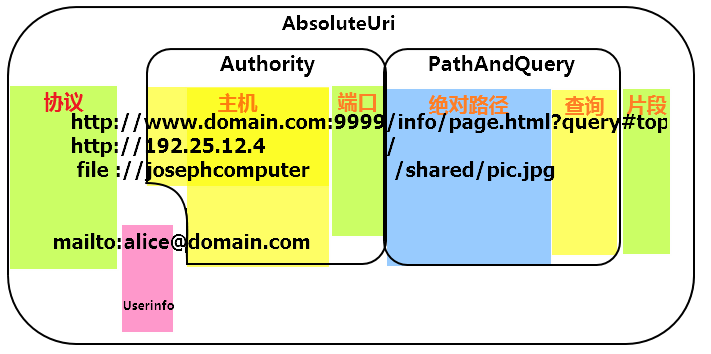
在构造函数中传入以下字符串之一,就可以创建一个 Uri 对象:
- URI字符串,例如http://www.ebay.com 或 file://janespc/sharedpics/dolphin.jpg
- 硬盘中一个文件的绝对路径,例如 c:\myfiles\data.xls
- LAN中一个文件的 UNC路径,例如 \janespc\sharedpics\dolphin.jpg
文件和UNC路径会自动转换为URI:添加协议 "file:",反斜杠会转换为斜杠。Uri的构造函数在创建Uri之前也会对传入的字符串执行一些基本的清理操作,包括将协议和主机名转换为小写、删除默认端口和空端口号。如果传入一个不带协议的URI字符串,例如"www.test.com",那么会抛出一个 UriFormatException 异常。
Uri 有一个 IsLoopback 属性,它表示 Uri 是否引用本地主机(IP地址为127.0.0.1),以及一个 IsFile 属性,它表示Uri是否引用一个本地或UNC(IsUnc)路径。如果 IsFile 返回 true,LocalPath 属性会返回一个符合本地操作系统习惯的 AbsolutePath(带反斜杠),然后可以用它来调用 File.OPen。
Uri 的实例有一些只读属性。要修改一个 Uri,我们需要实例化一个 UriBuilder 对象,这是一个可写属性,它可以通过 Uri 属性转换为 Uri。
Uri info = new Uri("http://www.domain.com:80/hosting/");
Uri page = new Uri("http://www.domain.com/hosting/page.html");
Console.WriteLine(info.Host); //www.domain.com
Console.WriteLine(info.Port); //80
Console.WriteLine(page.Port); //80
Console.WriteLine(info.IsBaseOf(page)); //True
Uri relative = info.MakeRelativeUri(page);
Console.WriteLine(relative.IsAbsoluteUri); //Flase
Console.WriteLine(relative.ToString()); //page.htmlUri 一些静态方法:
Uri.EscapeDataString(url);
UriHostNameType type = Uri.CheckHostName(url);
bool isScheme = Uri.CheckSchemeName(url);16.4 客户端类
WebRequest 和 WebRespone是管理 HTTP 和 FTP 客户端活动及 "file:" 协议的通用基类。
WebClient 是一个便利的门面类。它负责调用 WebRequest 和 WebRespone,可以节省很多编码。WebClient 支持字符串、字节数组、文件和流,而 WebRequest 和 WebRespone 只支持流。但是,WebClient不是万能的,因为它不支持某些特性(如cookie)。
HttpClient 是另一个基于 WebRequest 和 WebRespone 的类(更准确说基于HttpWebRequest和HttpWebResponse),Framework 4.5 引入。
WebClient主要作为请求/响应类之上薄薄的一层,而 HttpClient 则增加更多功能,能够处理基于HTTP的Web API、基于REST的服务和自定义验证模式。
WebClient和HttpClient都支持以字符串或字节数组方式处理简单的文件下载/上传操作。它们都拥有一些异步方法,但是只有 WebClient 支持进度报告。
| 请求/响应类 | 引入 | 异步进度报告 | |
|---|---|---|---|
| WebClient | 薄薄一层 | - | 有 |
| HttpClient | 处理基于HTTP的Web API等 | Framework 4.5 | 无 |
提示:WinRT应用程序不能使用
WebClient,必须使用WebRequest/WebResponse或HttpClient(用于HTTP连接)
16.4.1 WebClient
WebClient 使用步骤:
- 实例化一个
WebClient对象。 - 设置
Proxy属性值。 - 在需要验证时设置
Credentials属性值。 - 使用响应的 URI 调用
DownliadXXX或UploadXXX方法。
下载方法有:
public void DownloadFile(string address, string fileName);
public string DownloadString(string address);
public byte[] DownloadData(string address);
public Stream OpenRead(string address);每一个方法都有重载,接收 URI 对象代替字符串地址的参数。上传类似,返回包含服务器响应的值:
public byte[] UploadFile(string address, string fileName);
public byte[] UploadFile(Uri address, string fileName);
public byte[] UploadFile(string address, string method, string fileName);
public byte[] UploadFile(Uri address, string method, string fileName);
...
public string UploadString(string address, string data);
public byte[] UploadData(string address, byte[] data);
public Stream OpenWrite(string address);
...UploadValues 方法可用于以 POST 方法参数提交一个 HTTP 表单的值。WebClient 还包含一个 BaseAddress 属性,可用于为所有地址添加一个字符串前缀,如http://www.mysite.com/data。
public byte[] UploadValues(string address, NameValueCollection data);
...例子,下载 http://www.cnblogs.com/artwl/archive/2012/03/07/2382848.html 并以 code111.htm 保存
System.Net.WebClient webClient = new System.Net.WebClient();
webClient.Proxy = null;
webClient.DownloadFile("http://www.cnblogs.com/artwl/archive/2012/03/07/2382848.html", "code111.htm");
System.Diagnostics.Process.Start("code111.htm");从 Framework 4.5 开始,WebClient 提供了长任务方法的异步版本,他们会返回可以等待的任务
await webClient.DownloadFileTaskAsync("http://www.qq.com", "wegpage.htm");这些方法使用"TaskAsync"后缀,不同于使用"Async"后缀的EAP旧异步方法。但是,新方法不支持取消操作和进步报告的标准“TAP”模式。相反,在处理延续时,必须调用 WebClient 对象的 CanceAsync 方法;而处理报告时,需要处理 DownloadProgressChanged/UploadProgressChanged 事件。
下面例子下载一个网页并显示进度报告,如果下载超过5秒,则取消下载。
//winform.
private void button1_Click(object sender, EventArgs e)
{
Test();
}
async Task Test()
{
var wc = new WebClient();
wc.DownloadProgressChanged += (sender, args) =>
// 获取异步任务的进度百分比
Console.WriteLine(args.ProgressPercentage + "% 完成");
Task.Delay(5000).ContinueWith(ant => wc.CancelAsync());
await wc.DownloadFileTaskAsync("http://www.qq.com", "wegpage.htm");
}提示: 当请求取消时,程序会抛出一个 WebException 异常,它的 Status 属性是 WebExceptionStatus.RequestCanceled.(历史原因不抛出 OpeerationCanceledException 异常。)
捕捉与进度相关的事件,将它们提交到激活的同步上下文,所以它们的处理器不需要使用 Dispatcher.BeginInvoke,就可以更新UI控件。
警告: 如果需要使用取消操作或进度报告,要避免使用同一个 WebClient 对象依次执行多个操作,因为这样形成竞争条件。
16.4.2 WebRequest 和 WebResponse
比 WebClient 复杂,但是更灵活。
1.使用一个 URI 调用 WebRequest.Create,创建一个 Web 请求实例。
2.设置 Proxy 属性。
3.如果需要身份验证,设置 Credentials 属性。
如果要上传数据,则:
4.调用请求对象的GetRequestStream,然后在流中写入数据。如果需要处理响应,则转到第5步。如果要下载数据,则:
5.调用请求对象的GetResponse,创建一个 Web 响应实例。
6.调用响应对象的 GetResponseStream,然后(可以使用 StreamReader)从流中读取数据。
下面例子演示如何下载和显示一个示例网页
//同步
public static void Test1()
{
WebRequest req = WebRequest.Create("http://www.baidu.com"); //1.
req.Proxy = null; //2.
using (WebResponse res = req.GetResponse()) //5.下载
{
using (Stream rs = res.GetResponseStream()) //6.
{
using (FileStream fs = File.Create("code.html"))
{
rs.CopyTo(fs);
}
}
}
}异步方式
//异步
public static async void AsyncTest()
{
WebRequest req = WebRequest.Create("http://www.qq.com");
req.Proxy = null;
using (WebResponse res = await req.GetResponseAsync())
{
using (Stream rs = res.GetResponseStream())
{
using (FileStream fs = File.Create("code2.html"))
{
await rs.CopyToAsync(fs);
}
}
}
}静态方法 Create 会创建一个 WebRequest 类型的子类实例,如 HttpWebRequest 或 FtpWebRequest。
它选择的子类取决 URI 的前缀。
| 前缀 | Web请求类型 |
|---|---|
| http:或https: | HttpWebRequest |
| ftp: | FtpWebRequest |
| file: | FileWebRequest |
此外,调用 WebRequest.RegisterPrefix,可以注册自定义前缀。
WebRequest 包含一个 Timeout 属性,单位为毫秒。如果出现超时,那么会抛出一个 WebException 异常,其中包含一个 Status 属性,WebExceptionStatus.Timeout。HTTP默认超时时间为100秒,而FTP超时时间为无限。
WebRequest 对象不能回收并用于处理多个请求——每个实例只适用于一个作业。
16.4.3 HttpClient
HttpClient 在 HttpWebRequest 和 HttpWebRespone 之上提供了另一层封装。它的设计是为了支持越来越多的 Web API 和 REST 服务,在处理比获取网页等更复杂的协议时实现比 WebClient 更佳的体验。
- 一个 HttpClient 就可以支持并发请求。(使用 WebClient 处理并发请求,需要为每一个并发线程创建一个新实例,需要自定义请求头、cookies和验证模式,因此很麻烦)
- HttpClient 可用于编写和插入自定义消息处理器。这样可以创建单元测试桩函数,以及创建自定义管道(用于记录日志、压缩、加密等)调用WebClient的单元测试代码则很难编写。
HttpClient 包含丰富的可扩展的请求头与内容类型系统。
HttpClient 不能完全替代 WebClient,因为它不支持进度报告。WebClient 也有一个有点,它支持 FTP、file://和自定义URI模式,适应所有Framework版本。
简单 HttpClient 使用方法创建一个实例,然后使用 URI 调用 其中一个 Get* 方法:
string html = await new HttpClient().GetStringAsync("http://linqpad.net");(另外还有 GetByteArrayAsync和GetStreamAsync)HttpClient的所有 I/O 密集型方法都是异步的(没有同步版本)。
与 WebClient 不同,想获取最佳性能 HttpClient,必须重用相同的实例。HttpClient 允许并发操作,所以下面语句合法。同时下载两个网页:
var client = new HttpClient();
var tast1 = client.GetStringAsync("http://www.linqpad.net");
var tast2 = client.GetStringAsync("http://www.albahari.com");
Console.WriteLine(await task1);
Console.WriteLine(await task2);HttpClinet 包含一个 TimeOut 属性和一个 BaseAddress 属性,为每一个请求添加一个 URI 前缀。
HttpClient 在一定程度上就是一层实现:通常使用的大部分属性都定义在另一个类中,即 HttpClientHandler。要访问这个类,先创建一个实例,然后将这个实例传递给 HttpClient 的构造方法:
var handler = new HttpClientHandler{UseProxy = false};
var client = new HttpClient(handler);
...这个例子在处理器中禁用了代理支持。此外,还有其他一些属性可用于控制 cookies、自动重定向、验证等(后续看16.5“HTTP访问”)
1.GetAsync与响应消息
GetStringAsync、GetByteArrayAsync和GetStreamAsync方法是更常用的 GetAsync 方法的快捷方法。GetAsync方法会返回一个响应消息:
var client = new HttpClient();
//GetAsync 方法也接受一个 CancellationToken
HttpResponseMessage response = await client.GetAsync("http://www.baidu.com");
response.EnsureSuccessStatusCode();
string html = await response.Content.ReadAsStringAsync();
Console.WriteLine(html);HttpResponseMessage 包含一些访问请求头,和HTTP StatusCode 的属性,与 WebClient 不同。除非显示地调用 EnsureSuccessStatusCode,否则返回不成功状态(如404,资源未找到)不会抛出异常,然而,通信或DNS错误会抛出异常。
HttpResponseMessage 包含一个 CopyToAsync 方法,它可以将数据写到一个流中,适用于将输入写到一个文件中:
using (var fileStream =File.Create("linqpad.htm"))
{
await response.Content.CopyToAsync(fileStream);
}GetAsync 是与 HTTP 的4种动作相关的4个方法之一(PostAsync,PutAsync,DeleteAsync)
2.SendAsync与请求消息
这是访问所有数据的唯一低层方法,要使用这个类,首先要创建一个 HttpRequestMessage
var client = new HttpClient();
var request = new HttpRequestMessage(HttpMethod.Get, "http://www.weibo.com");
HttpResponseMessage response = await client.SendAsync(request);
response.EnsureSuccessStatusCode();
...创建一个 HttpResponseMessage 对象,意味着可以自定义请求的属性,如请求头和内容本身,它们可用于上传数据。
3.上传数据与HttpContent
创建一个 HttpRequestMessage 对象以后,设置它的 Content 属性,就可以上传内容。这个属性类型是抽象类 HttpContent。
Framework包含下面子类,对应不同类型。
- ByteArrayContent
- StreamContent
- FormUrlEncodedContent
- StreamContent
var client = new HttpClient(new HttpClientHandler() {UseProxy = false});
var request = new HttpRequestMessage(HttpMethod.Post, "http://www.albahari.com/EchoPost.aspx");
request.Content = new StringContent("This is a test");
HttpResponseMessage response = await client.SendAsync(request);
response.EnsureSuccessStatusCode();
Console.WriteLine(await response.Content.ReadAsStringAsync());4.HttpMessageHandler
前面说过,大多数自定义请求属性不在 HttpClient 中定义,而在 HttpClientHandler 中定义。后者实际是 HttpMessageHandler 的子类,
public abstract class HttpMessageHandler : IDisposable
{
protected internal abstract Task SendAsync
(HttpRequestMessage request, CancellationToken cancellationToken);
public void Dispose();
protected virtual void Dispose(bool disposing);
} SendAsync 方法是在 HttpClient 的 SendAsync 方法中调用。
HttpMessageHandler 非常容易继承,同时提供 HttpClient 的扩展点。
5.单元测试与桩处理器
创建 HttpMessageHandler 的子类,就可以创建一个帮助进行单元测试的桩处理器:
...
6.使用实现处理器链
创建 DelegatingHandler 的子类,就可以创建一个调用其他消息处理器的消息处理器(形成处理器链)。这种方法适用于实现自定义身份验证、压缩和加密协议。
例子,简单的日志处理器:
class LoggingHandler : DelegatingHandler
{
public LoggingHandler(HttpMessageHandler nextHandler)
{
InnerHandler = nextHandler;
}
protected async override Task SendAsync
(HttpRequestMessage request, CancellationToken cancellationToken)
{
Console.WriteLine("Requesting:" + request.RequestUri);
var response = await base.SendAsync(request, cancellationToken);
Console.WriteLine("Got response:" + response.StatusCode);
return response;
}
} 这里重写 SendAsync 时保持异步性。在重载任务的方法时添加 async 修饰符是绝对合法的如这个例子。
相对于将信息直接写到控制台,更好的方法是给构造方法传入某种日志记录对象。最好是接受一对 Action 代理,然后让他们记录请求和响应对象的日志信息。
16.4.4 代理
16.4.5 身份验证
创建一个 NetworkCredential 对象,...
16.4.6 异常处理
16.5 HTTP访问
16.5.1 请求头
WebClient、WebRequest 和 HttpClient 都可以添加自定义HTTP请求头,以及在响应中列举请求头信息。
请求头只是一些键/值对,其中包含相应的元数据,如消息内容类型或服务器软件。
例子演示如何在请求中添加自定义请求头信息,然后在 HttpClient 的响应消息中列举所有请求头信息:
WebClient wc =new WebClient();
wc.Proxy = null;
wc.Headers.Add("CustomHeader","JustPlaying/1.0");
wc.DownloadString("http://www.cnblogs.com");
foreach (string name in wc.ResponseHeaders.Keys)
{
Console.WriteLine(name + "=" + wc.ResponseHeaders[name]);
}相反,HttpClient 包含一些强类型集合,其中包含与标准HTTP头信息相对应的属性。DefaultRequestHeaders 属性包含适用于每一个请求的头信息:
var client = new HttpClient(handler); //handler = new HttpClientHandler() { UseProxy = false };
client.DefaultRequestHeaders.UserAgent.Add(
new ProductInfoHeaderValue("VisualStudio","2013")
);
client.DefaultRequestHeaders.Add("CustomHeader", "VisualStudio/2013");而 HttpRequestMessage 类的 Headers 属性则包含请求头特有的头信息。
16.5.2 查询字符串
?key1=value1&key2=value2&key3=value3...
WebClient 包含一个字段风格的属性,它可以简化查询字符串的操作。
例子,在百度搜索单词 "WebClient" ,然后显示结果:
WebClient wc = new WebClient();
wc.Proxy = null;
wc.QueryString.Add("wd", "WebClient"); // Search for "WebClient"
//wc.QueryString.Add("hl", "fr"); // 本来想法语,貌似错的,这个是谷歌规则
wc.DownloadFile("http://www.baidu.com/s", "results.html");
System.Diagnostics.Process.Start("results.html");如果要使用 WebRequest 或 HttpClient 实现相同效果,那么必须手工赋值给请求URL正确格式字符串:
string requestURI = "https://www.baidu.com/s?wd=webclient";如果查询中包含符号或空格,那么使用 URI 的 EscapeDataString 方法:
string search = Uri.EscapeDataString("(WebClient OR HttpClient)");
string language = Uri.EscapeDataString("fr");
string requestURI = "http://www.google.com/search?q=" + search +
"&hl=" + language;结果为 http://www.google.com/search?q=(WebClient%20OR%20HttpClient)&hl=fr
16.5.3 上传表单数据
WebClent 的 UploadValues 方法可以把HTML表单的方式提交数据:
WebClient wc = new WebClient();
wc.Proxy = null;
var data = new System.Collections.Specialized.NameValueCollection();
data.Add("Name", "Joe Albahari");
data.Add("Company", "O'Reilly");
byte[] result = wc.UploadValues("http://www.albahari.com/EchoPost.aspx",
"POST", data);
Console.WriteLine(Encoding.UTF8.GetString(result));结果:You posted=Name=Joe+Albahari&Company=O'Reilly
NameValueCollection 中的键(如 searchtextbox 和 searchMode) 与HTML表单的输入框相对应。使用 WebRequest 上传表单数据操作更复杂。(如果需要使用 cookies等特性,则必须采用这种方法)
下面是具体操作过程:
- 将请求的 ContentType 设置为 "application/x-www.form-urlencoded",将它的方法设置为“POST”。
- 创建一个包含上传数据的字符串,并且将其编码为:
name1=value1&name2=value2&name3=value3... - 使用 Encoding.UTF8.GetBytes 将字符串转为字节数组。
- 将 Web 请求的 ContentLength 属性设置为字节组的长度。
- 调用 Web 请求的 GetRequestStream,然后写入数据数组。
- 调用 GetResponse,读取服务器的响应。
//WebRequest 上传表单数据
var req = WebRequest.Create ("http://www.albahari.com/EchoPost.aspx");
req.Proxy = null;
req.Method = "POST";
req.ContentType = "application/x-www-form-urlencoded";
string reqString = "Name=Joe+Albahari&Company=O'Reilly";
byte[] reqData = Encoding.UTF8.GetBytes (reqString);
req.ContentLength = reqData.Length;
using (Stream reqStream = req.GetRequestStream())
reqStream.Write (reqData, 0, reqData.Length);
using (WebResponse res = req.GetResponse())
using (Stream resSteam = res.GetResponseStream())
using (StreamReader sr = new StreamReader (resSteam))
Console.WriteLine (sr.ReadToEnd());如果使用 HttpClient,则要创建和生成 FormUrlEncodedContent 对象,然后再传递到 PostAsync 方法,或者设置到请求的 Content 属性上。
//HttpClient 上传表单数据
string uri = "http://www.albahari.com/EchoPost.aspx";
var client = new HttpClient();
var dict = new Dictionary
{
{ "Name", "Joe Albahari" },
{ "Company", "O'Reilly" }
};
var values = new FormUrlEncodedContent (dict);
var response = await client.PostAsync (uri, values);
response.EnsureSuccessStatusCode();
Console.WriteLine (await response.Content.ReadAsStringAsync()); 16.5.4 Cookies
Cookies是名称/值字符串对,它是HTTP服务器通过响应头发送到客户端。Web浏览器客户端一般会记住cookie,然后在终止之前,后续请求都会将它们重复发送给服务器(相同地址)。
Cookie 使服务器知道它是否正在连接之前连接过的相同客户端,从而不需要在URI重复添加负责查询字符串。
默认情况,HttpWebRequest 会忽略从服务器接收的任意 cookie。为了接收 cookie,必须创建一个 CookieCotainer 对象,然后分配到WebRequest。然后,就可以列举响应中接收到的 cookie:
CookieContainer cc = new CookieContainer();
var request = (HttpWebRequest) WebRequest.Create ("http://www.baidu.com");
request.Proxy = null;
request.CookieContainer = cc;
using (var response = (HttpWebResponse) request.GetResponse())
{
foreach (Cookie c in response.Cookies)
{
Console.WriteLine (" Name: " + c.Name);
Console.WriteLine (" Value: " + c.Value);
Console.WriteLine (" Path: " + c.Path);
Console.WriteLine (" Domain: " + c.Domain);
}
// Read response stream 读取响应流...
}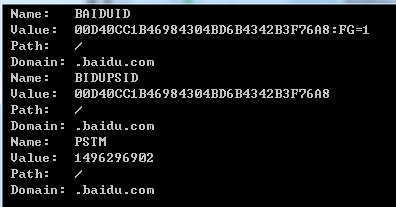
如果使用 HttpClient,则需要创建一个 HttpClientHandler 实例:
var cc = new CookieContainer();
var handler = new HttpClientHandler();
handler.CookieContainer = cc; //设置
var client = new HttpClient (handler);WebClient 不支持 cookie。
如果需要在将来的请求上接收到的 cookie,则只需要给每一个新的 WebRequest 对象设置相同的 CookieContainer 对象,或者在 HttpClient 中使用相同对象发送请求。
CookieContainer 是可序列化的类,所以它可以写到磁盘中。此外,可以先使用一个新的 CookieContainer,然后再按照下面的方法手动添加cookie:
CookieContainer cc = new CookieContainer();
....
Cookie c = new Cookie("BAIDUID","00DD40CC4B46....."
,"/",".baidu.com");
cc.Add(c);16.5.5 表单验证
16.4.5 身份验证 介绍如何使用 NetworkCredentials 对象实现其中一些类型的验证,如Basic或NTLM(在 Web浏览器弹出一个对话框)。然而,大多数验证的网站都使用某种基于表单的方法。
用户在文本框输入用户名和密码,单击按钮提交数据,然后在成功验证之后接收到 cookie,这个 cookie 属于所访问网页的私有数据。通过 WebRequest 或 HttpClient,就可以实现。
下面演示 WebRequest/WebResponse 登录网站:
string loginUri = "http://www.somesite.com/login";
string username = "username"; // (Your username)
string password = "password"; // (Your password)
string reqString = "username=" + username + "&password=" + password;
byte[] requestData = Encoding.UTF8.GetBytes (reqString);
CookieContainer cc = new CookieContainer();
var request = (HttpWebRequest)WebRequest.Create (loginUri);
request.Proxy = null;
request.CookieContainer = cc;
request.Method = "POST";
request.ContentType = "application/x-www-form-urlencoded";
request.ContentLength = requestData.Length;
using (Stream s = request.GetRequestStream())
s.Write (requestData, 0, requestData.Length);
using (var response = (HttpWebResponse) request.GetResponse())
foreach (Cookie c in response.Cookies)
Console.WriteLine (c.Name + " = " + c.Value);
//我们现在已经成功登录,只要给后续的 WebRequest 对象添加 cc,就可以保持已验证用户的状态使用 HttpClient 实现的方法:
string loginUri = "http://www.somesite.com/login";
string username = "username";
string password = "password";
CookieContainer cc = new CookieContainer();
var handler = new HttpClientHandler { CookieContainer = cc };
var request = new HttpRequestMessage (HttpMethod.Post, loginUri);
request.Content = new FormUrlEncodedContent (new Dictionary
{
{ "username", username },
{ "password", password }
});
var client = new HttpClient (handler);
var response = await client.SendAsync (request);
response.EnsureSuccessStatusCode(); 16.5.6 SSL
16.6 编写HTTP服务器
我们可以使用 HttpListener 类编写自定义 HTTP 服务器,下面是一个监听端口 51111 的简单服务器,它会等待一个客户端请求,然后返回一行回复。
static void Main()
{
ListenAsync(); // Start server
WebClient wc = new WebClient(); // Make a client request.
Console.WriteLine (wc.DownloadString
("http://localhost:51111/MyApp/Request.txt"));
}
async static void ListenAsync()
{
HttpListener listener = new HttpListener();
listener.Prefixes.Add ("http://localhost:51111/MyApp/"); // Listen on
listener.Start(); // port 51111.
// Await a client request:
HttpListenerContext context = await listener.GetContextAsync();
// Respond to the request:
string msg = "You asked for: " + context.Request.RawUrl;
context.Response.ContentLength64 = Encoding.UTF8.GetByteCount (msg);
context.Response.StatusCode = (int) HttpStatusCode.OK;
using (Stream s = context.Response.OutputStream)
using (StreamWriter writer = new StreamWriter (s))
await writer.WriteAsync (msg);
listener.Stop();
}输出:You asked for: /MyApp/Request.txt
HttpListener 内部并步使用 .net Socket 对象,相反,它调用 Windows HTTP Server API。支持计算机中多个应用程序监听相同的IP地址和端口,前提是每一个应用程序都注册不同的地址前缀。
调用 GetContext 时,HttpListener 会等待下一个客户端请求,这个方法会返回一个对象,其中包含 Request 和 Response 属性。每一个属性都与 WebRequest 和 WebResponse 对象类似,但是它们属于服务器。例如,我们可以读写请求和响应对象的头信息和 Cookie,使用的方法与客户端非常类似。
我们可以基于预期客户端类型选择如何支持 HTTP 协议特性。至少,每一个请求都需要设置内容长度和状态码。
下面这个简单网页服务器,最多支持50并发请求:
using System;
using System.IO;
using System.Net;
using System.Threading.Tasks;
class WebServer
{
HttpListener _listener;
string _baseFolder; // Your web page folder.
public WebServer (string uriPrefix, string baseFolder)
{
_listener = new HttpListener();
_listener.Prefixes.Add (uriPrefix);
_baseFolder = baseFolder;
}
public async void Start()
{
_listener.Start();
while (true)
try
{
var context = await _listener.GetContextAsync();
Task.Run (() => ProcessRequestAsync (context));
}
catch (HttpListenerException) { break; } // Listener stopped.
catch (InvalidOperationException) { break; } // Listener stopped.
}
public void Stop() { _listener.Stop(); }
async void ProcessRequestAsync (HttpListenerContext context)
{
try
{
string filename = Path.GetFileName (context.Request.RawUrl);
string path = Path.Combine (_baseFolder, filename);
byte[] msg;
if (!File.Exists (path))
{
Console.WriteLine ("Resource not found: " + path);
context.Response.StatusCode = (int) HttpStatusCode.NotFound;
msg = Encoding.UTF8.GetBytes ("Sorry, that page does not exist");
}
else
{
context.Response.StatusCode = (int) HttpStatusCode.OK;
msg = File.ReadAllBytes (path);
}
context.Response.ContentLength64 = msg.Length;
using (Stream s = context.Response.OutputStream)
await s.WriteAsync (msg, 0, msg.Length);
}
catch (Exception ex) { Console.WriteLine ("Request error: " + ex); }
}
}下面是启动程序的 Main 方法:
static void Main()
{
// Listen on port 51111, serving files in d:\webroot:
var server = new WebServer ("http://localhost:51111/", @"d:\webroot");
try
{
server.Start();
Console.WriteLine ("Server running... press Enter to stop");
Console.ReadLine();
}
finally { server.Stop(); }
}可以使用任何一个 Web 浏览器作为客户端进行测试,这里的URI是 http://localhost/ 加上网站名称。
警告: 如果其他软件占用同一个端口,那么 HttpListener 不会启动(除非这个软件也使用Windows HTTP Server API)
使用异步函数可以实现服务器的可扩展性和提高运行效率。然而,从UI线程开始都可能会影响可扩展性,因为每一个请求中,执行过程都会在每一次等待之后返回UI线程。这种等待毫无意义,因为没有共享的状态。所以UI中,最好去掉UI线程,或者这样:Task.Run(start);
或者在调用 GetContextAsync 之后调用 ConfigureAwait(false)。
注意,即使这些方法是异步的,但我们仍然在 Task.Run 中调用 ProcessRequestAsync。这样就尅允许调用者马上能够处理另一个请求,而不需要同步等待方法执行结束(一直到第一个 await)。
